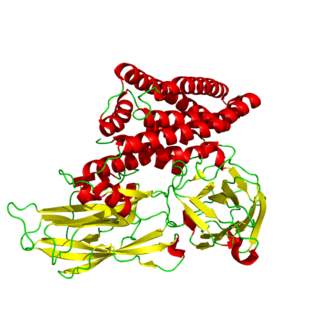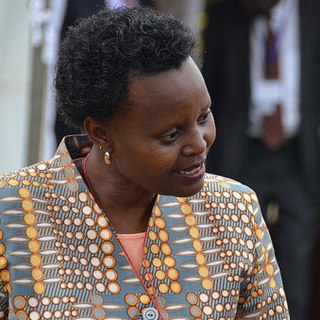
Biotechnology is a multidisciplinary field that involves the integration of natural sciences and engineering sciences in order to achieve the application of organisms, cells, parts thereof and molecular analogues for products and services.

Genetically modified maize (corn) is a genetically modified crop. Specific maize strains have been genetically engineered to express agriculturally-desirable traits, including resistance to pests and to herbicides. Maize strains with both traits are now in use in multiple countries. GM maize has also caused controversy with respect to possible health effects, impact on other insects and impact on other plants via gene flow. One strain, called Starlink, was approved only for animal feed in the US but was found in food, leading to a series of recalls starting in 2000.

Genetic engineering, also called genetic modification or genetic manipulation, is the modification and manipulation of an organism's genes using technology. It is a set of technologies used to change the genetic makeup of cells, including the transfer of genes within and across species boundaries to produce improved or novel organisms. New DNA is obtained by either isolating and copying the genetic material of interest using recombinant DNA methods or by artificially synthesising the DNA. A construct is usually created and used to insert this DNA into the host organism. The first recombinant DNA molecule was made by Paul Berg in 1972 by combining DNA from the monkey virus SV40 with the lambda virus. As well as inserting genes, the process can be used to remove, or "knock out", genes. The new DNA can be inserted randomly, or targeted to a specific part of the genome.
Agricultural biotechnology, also known as agritech, is an area of agricultural science involving the use of scientific tools and techniques, including genetic engineering, molecular markers, molecular diagnostics, vaccines, and tissue culture, to modify living organisms: plants, animals, and microorganisms. Crop biotechnology is one aspect of agricultural biotechnology which has been greatly developed upon in recent times. Desired trait are exported from a particular species of Crop to an entirely different species. These transgene crops possess desirable characteristics in terms of flavor, color of flowers, growth rate, size of harvested products and resistance to diseases and pests.

Genetically modified foods, also known as genetically engineered foods, or bioengineered foods are foods produced from organisms that have had changes introduced into their DNA using various methods of genetic engineering. Genetic engineering techniques allow for the introduction of new traits as well as greater control over traits when compared to previous methods, such as selective breeding and mutation breeding.

Genetically modified crops are plants used in agriculture, the DNA of which has been modified using genetic engineering methods. Plant genomes can be engineered by physical methods or by use of Agrobacterium for the delivery of sequences hosted in T-DNA binary vectors. In most cases, the aim is to introduce a new trait to the plant which does not occur naturally in the species. Examples in food crops include resistance to certain pests, diseases, environmental conditions, reduction of spoilage, resistance to chemical treatments, or improving the nutrient profile of the crop. Examples in non-food crops include production of pharmaceutical agents, biofuels, and other industrially useful goods, as well as for bioremediation.
Bt cotton is a genetically modified pest resistant plant cotton variety that produces an insecticide to combat bollworm.

Genetically modified plants have been engineered for scientific research, to create new colours in plants, deliver vaccines, and to create enhanced crops. Plant genomes can be engineered by physical methods or by use of Agrobacterium for the delivery of sequences hosted in T-DNA binary vectors. Many plant cells are pluripotent, meaning that a single cell from a mature plant can be harvested and then under the right conditions form a new plant. This ability is most often taken advantage by genetic engineers through selecting cells that can successfully be transformed into an adult plant which can then be grown into multiple new plants containing transgene in every cell through a process known as tissue culture.
The United States is the largest grower of commercial crops that have been genetically engineered in the world, but not without domestic and international opposition.

The Non-GMO Project is a 501(c)(3) non-profit organization focusing on genetically modified organisms. The organization began as an initiative of independent natural foods retailers in the U.S. and Canada, with the stated aim to label products produced in compliance with their Non-GMO Project Standard, which aims to prevent genetically modified foodstuffs from being present in retail food products. The organization is headquartered in Bellingham, Washington. The Non-GMO label began use in 2012 with Numi Organic Tea products.

A genetically modified soybean is a soybean that has had DNA introduced into it using genetic engineering techniques. In 1996, the first genetically modified soybean was introduced to the U.S. by Monsanto. In 2014, 90.7 million hectares of GM soybeans were planted worldwide, this is almost 82% of the total soybeans cultivation area.
Genetically modified canola is a genetically modified crop. The first strain, Roundup Ready canola, was developed by Monsanto for tolerance to glyphosate, the active ingredient in the commonly used herbicide Roundup.

The regulation of genetic engineering varies widely by country. Countries such as the United States, Canada, Lebanon and Egypt use substantial equivalence as the starting point when assessing safety, while many countries such as those in the European Union, Brazil and China authorize GMO cultivation on a case-by-case basis. Many countries allow the import of GM food with authorization, but either do not allow its cultivation or have provisions for cultivation, but no GM products are yet produced. Most countries that do not allow for GMO cultivation do permit research. Most (85%) of the world's GMO crops are grown in the Americas. One of the key issues concerning regulators is whether GM products should be labeled. Labeling of GMO products in the marketplace is required in 64 countries. Labeling can be mandatory up to a threshold GM content level or voluntary. A study investigating voluntary labeling in South Africa found that 31% of products labeled as GMO-free had a GM content above 1.0%. In Canada and the USA labeling of GM food is voluntary, while in Europe all food or feed which contains greater than 0.9% of approved GMOs must be labelled.
Genetic engineering in the European Union has varying degrees of regulation.

Cry1Ac protoxin is a crystal protein produced by the gram-positive bacterium, Bacillus thuringiensis (Bt) during sporulation. Cry1Ac is one of the delta endotoxins produced by this bacterium which act as insecticides. Because of this, the genes for these have been introduced into commercially important crops by genetic engineering in order to confer pest resistance on those plants.
India and China are the two largest producers of genetically modified products in Asia. India currently only grows GM cotton, while China produces GM varieties of cotton, poplar, petunia, tomato, papaya and sweet pepper. Cost of enforcement of regulations in India are generally higher, possibly due to the greater influence farmers and small seed firms have on policy makers, while the enforcement of regulations was more effective in China. Other Asian countries that grew GM crops in 2011 were Pakistan, the Philippines and Myanmar. GM crops were approved for commercialisation in Bangladesh in 2013 and in Vietnam and Indonesia in 2014.
Genetic engineering in North America is any genetic engineering activities in North America
Brazil and Argentina are the 2nd and 3rd largest producers of genetically modified food behind the United States.

Margaret Gathoni Karembu is a Kenyan science educator and science management specialist in the fields of technology transfer and the applications of biotechnology in Africa. She is the Director of the AfriCenter division of the ISAAA, a non-profit international organization that shares agricultural biotechnology, focusing on genetic engineering. She is the chair of the Open Forum on Agricultural Biotechnology Programming Committee, Kenya Chapter.





